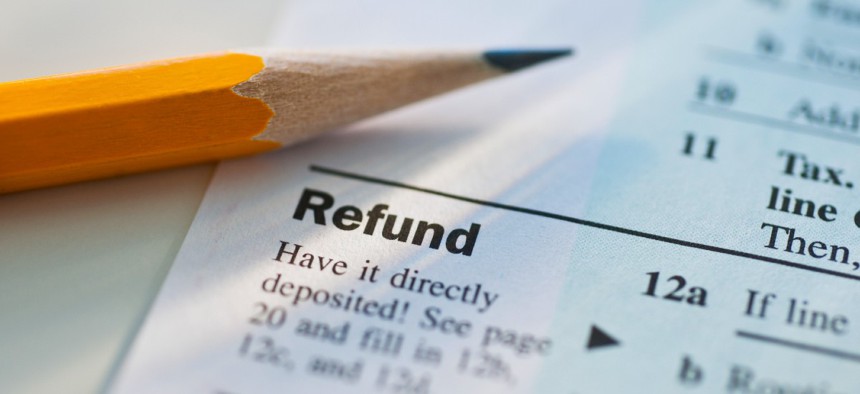
Tetra Images/Getty Images
IRS Aims to Clear Backlogged Tax Returns by the End of Year
As of March 18, the backlog of unprocessed paper tax returns was at nearly 15 million but IRS Commissioner Charles Rettig told lawmakers that he wants to get that to a “healthy” level.
IRS Commissioner Charles Rettig told lawmakers that the agency wants to get down to a “healthy level” of unprocessed paper tax returns by the end of the calendar year.
Budget cuts and added responsibilities during the pandemic, like delivering economic stimulus payments to Americans, contributed to the backlog, as did delays in modernization efforts, Rettig testified during an April 7 Senate Finance Committee hearing.
As of March 18, the backlog of unprocessed paper returns was at an “unprecedented” nearly 15 million, according to the National Taxpayer Advocate. That includes individual income tax returns, business tax returns and amended returns. Collins has also previously pointed to additional backlogs of paper correspondence at the agency.
Among other efforts, the agency is looking to hiring surges and paid overtime to process these returns and “get healthy by the end of the year,” Rettig said in his written testimony.
Rettig also pointed to funding levels that he says hinder progress.
The IRS budget request for fiscal year 2023 asks for $14.1 billion, or an 18.3% increase over the level given in fiscal 2022 continuing resolution, something that Rettig says will help with system modernization and taxpayer services.
The recently passed budget is the largest increase in two decades, according to Rettig, but he stressed that long-term budget cuts and the regular use of continuing resolutions still impact the agency.
“I believe that most every commissioner over the past decades has stated that inconsistent funding is among the most frustrating experiences for the federal agency that touches and serves more Americans than any other government or private-sector organization,” said Rettig.
“Modernized technology would significantly improve our ability to respond to a crisis, pandemic-related or otherwise. It is simply unacceptable for us to remain largely a paper-based organization operating in a digital world environment,” he continued.
The IRS’ budget has decreased by over 15% in real terms over the last decade. In fiscal 2021, the IRS had less than 79,000 full-time equivalent employees—close to 1974 levels, Rettig wrote in his testimony.
And employees still manually enter paper returns into IRS systems. According to Rettig’s written testimony, the IRS is looking to adopt scanning tech.
“We hope to be able to scan in a paper form and file it electronically later this summer, which will help us identify the potential for this approach to be used for other forms in the future,” he wrote.
Several lawmakers asked why the agency hasn’t used 2-D barcode technology, which would allow the agency to access paper return’s data in a machine-readable format with a scan. Tax return software companies would be responsible for the barcode while the agency would be able to process the return as if it was filed electronically.
Erin Collins, the National Taxpayer Advocate, issued a directive to the IRS in March directing the IRS to work with tax return software companies to make plans to use this barcode tech for the next filing season.
“During the past two decades, state tax agencies have been using scanning technology to automate the processing of paper tax returns,” she wrote in a blog on the directive. “During that time, the IRS has considered, rejected, proposed, reconsidered, partially implemented, and deferred the question of whether to implement scanning technology.”
Sen. Rob Portman (R-Ohio) also said that he and Sen. Ben Cardin (D-Md.) are working on a bill that would “provide additional funding for customer service” and require the use of 2-D scanning on paper returns, among other measures.
“The Congressional budget justification for each year between 2013 and 2017 requested funding for 2-D barcode and that funding was never provided,” said Rettig. “The agency then pivoted into focusing on electronic filing. And we're currently running around 96% e-filed income tax returns in our current filing season.”
For now, the latest budget request “supports our ability to scan and electronically convert paper into something that we can actually do machine readable and hopefully process automatically,” Rettig told lawmakers.
Another top priority for the agency is the modernization of the more than 60-year-old system called the Individual Master File, a key source for individual tax data.
A report from the Government Accountability Office last fall noted that the program to modernize it has been subject to multiple delays and cost changes since it started in 2009, and a modernized system isn’t scheduled to be done until 2030.
A six-year business modernization plan with an estimated $2.3 to $2.7 billion price tag was rolled out in 2019, but the IRS has only gotten 57% of the funding for the plan, said Rettig.
“From a modernization perspective, many of our priorities, including upgrading the Individual Master File, one of the oldest IT systems in the federal government, are multi-year efforts. This situation means we have not been able to invest in modernizing and integrating our technological infrastructure,” reads Rettig’s testimony.
The current budget proposal wouldn’t fund the master file project entirely, said Rettig, continuing on to say that that modernization effort is a long-term project.
“It is impossible to build a robust, meaningful technology infrastructure for any agency, for any private-sector organization, when we don't have consistent, timely, multi-year funding,” said Rettig.







